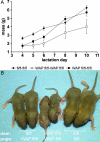Estrogen receptor-alpha expression in the mammary epithelium is required for ductal and alveolar morphogenesis in mice
- PMID: 17785410
- PMCID: PMC1976199
- DOI: 10.1073/pnas.0706933104
Estrogen receptor-alpha expression in the mammary epithelium is required for ductal and alveolar morphogenesis in mice
Abstract
The estrogen receptor-alpha (ERalpha) is a critical transcription factor that regulates epithelial cell proliferation and ductal morphogenesis during postnatal mammary gland development. Tissue recombination and transplantation studies using the first generation of ERalpha knockout (ERKO) mice suggested that this steroid hormone receptor is required in the mammary stroma that subsequently exerts its effect on the epithelium through additional paracrine signaling events. A more detailed analysis revealed that ERKO mice produce a truncated ERalpha protein with detectable transactivation activity, and it is likely that this functional ERalpha variant has masked the biological significance of this steroid receptor in the mammary epithelium. In this article, we describe the generation a Cre-lox-based conditional knockout of the ERalpha gene to study the biological function of this steroid receptor in the epithelial compartment at defined stages of mammary gland development. The mouse mammary tumor virus (MMTV)-Cre-mediated, epithelial-specific ablation of exon 3 of the ERalpha gene in virgin mice severely impaired ductal elongation and side branching. The conditional knockout resulted in ablation of the ERalpha protein, and the progesterone receptor (PR), whose expression is under the control of ERalpha, was largely absent. The whey acidic protein (WAP)-Cre-mediated deletion of ERalpha during successive gestation cycles resulted in a loss of ductal side-branching and lobuloalveolar structures, ductal dilation, and decreased proliferation of alveolar progenitors. These abnormalities compromised milk production and led to malnourishment of the offspring by the second lactation. These observations suggest that ERalpha expression in the mammary epithelium is essential for normal ductal morphogenesis during puberty and alveologenesis during pregnancy and lactation.
Conflict of interest statement
The authors declare no conflict of interest.
Figures





References
-
- Bocchinfuso WP, Lindzey JK, Hewitt SC, Clark JA, Myers PH, Cooper R, Korach KS. Endocrinology. 2000;141:2982–2994. - PubMed
-
- Korach KS, Couse JF, Curtis SW, Washburn TF, Lindzey J, Kimbro KS, Eddy EM, Migliaccio S, Snedeker SM, Lubahn DB, et al. Recent Prog Horm Res. 1996;51:159–188. - PubMed
-
- Kos M, Denger S, Reid G, Korach KS, Gannon F. J Mol Endocrinol. 2002;29:281–286. - PubMed
-
- Edery M, McGrath M, Larson L, Nandi S. Endocrinology. 1984;115:1691–1697. - PubMed
Publication types
MeSH terms
Substances
Grants and funding
LinkOut - more resources
Full Text Sources
Molecular Biology Databases
Research Materials

